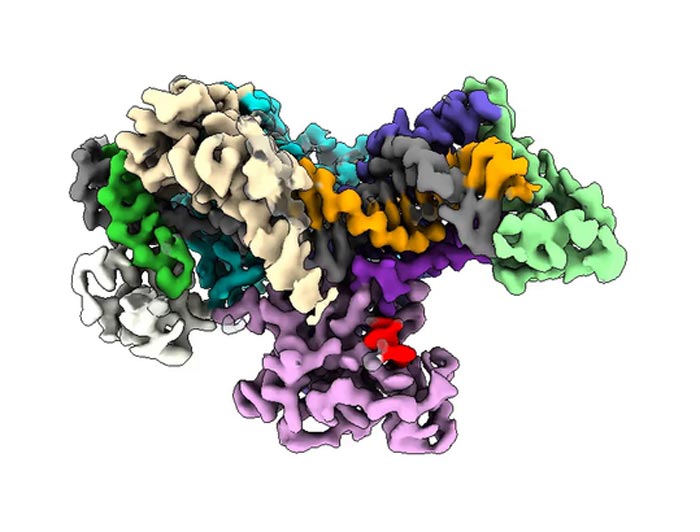‘Bacterial arch-enemy’ paves the way for new gene editing

Visualization of the molecular structure of CRISPR-Cas12j
Credit: University of Copenhagen
https://www.eurekalert.org/multimedia/781185
Researchers may have discovered a new and better genome editing technology than the existing CRISPR-Cas9, which has proved itself a revolution within biotechnology and medical sciences.
The similar but much smaller CRISPR-Cas12j system was recently found within the archenemy of bacteria – bacteriophages. These tiny organisms are viruses that can infect and kill bacteria while not being harmful to plants, animals or humans.
Researchers from the University of Copenhagen have now mapped the structure of CRISPR-Cas12j3 from bacteriophages. This is important in order to understand exactly how it works. The new study is published in the scientific journal Nature Communications.
“The bacteriophages may use CRISPR-Cas12j family members in nature as a defence CRISPR to defeat other viruses when they fight to infect and control host bacteria. It seems that there are several advantages for the use of this system as a biological method to edit genomes. In this study we used cryo-electron microscopy to determine the structure of CRISPR-Cas12j3 at high resolution. This information provides us with the first structural insight of this CRISPR-Cas family, thus revealing how it works,” says first author to the study Arturo Carabias, postdoc at the Novo Nordisk Foundation Center for Protein Research.
When trying to find out how systems like CRISPR-Cas12j3 work, it is important to map the molecular structure. The shape and structure of molecules reveal how they function and interact with other molecules when they carry out their function.
Solves a packaging problem
Researchers hope that the new system could provide resources with improved efficiencies and alternative targeting mechanisms, smaller cargoes for viral packaging or decreased immunogenicity.
The reason that CRISPR-Cas12j family members is interesting to investigate to the researchers is its size. Compared to CRISPR-Cas9 it is much smaller but retains the key functions for precise genome editing in a compact protein scaffold. This provides an advantage in the genome editing process when the molecular scissors are packaged into an Adenovirus in order to be delivered into an organism. In the case of CRISPR-Cas12j family members, it should be possible to include longer sequences to facilitate editing than for its larger cousins.
“CRISPR-Cas12j members need to be studied in depth before it can actually be applied in medical science and biotechnology. But in this study, we can see its vast potential for genome editing because it solves some of the packaging problems that CRISPR-Cas9 has,” says Guillermo Montoya, professor at the Novo Nordisk Foundation Center for Protein Research.
The researchers now hope to see the CRISPR Cas12j family members investigated further before it eventually can be implemented as a new gene editing technology.
DOI: 10.1038/s41467-021-24707-3
Method of Research: Experimental study
Article Title: Structure of the mini-RNA-guided endonuclease CRISPR-Cas12j3
Article Publication Date: 21-Jul-2021
COI Statement: Guillermo Montoya and Stefano Stella declare that they are co-founders of Twelve Bio. A patent application has been filed relating to this work. Arturo Carabias, Anders Fuglsang, Stefano Stella and Guillermo Montoya are co-inventors on the patent. The other authors declare no competing interests.
Media Contact
All latest news from the category: Life Sciences and Chemistry
Articles and reports from the Life Sciences and chemistry area deal with applied and basic research into modern biology, chemistry and human medicine.
Valuable information can be found on a range of life sciences fields including bacteriology, biochemistry, bionics, bioinformatics, biophysics, biotechnology, genetics, geobotany, human biology, marine biology, microbiology, molecular biology, cellular biology, zoology, bioinorganic chemistry, microchemistry and environmental chemistry.
Newest articles

Webb captures top of iconic horsehead nebula in unprecedented detail
NASA’s James Webb Space Telescope has captured the sharpest infrared images to date of a zoomed-in portion of one of the most distinctive objects in our skies, the Horsehead Nebula….

Cost-effective, high-capacity, and cyclable lithium-ion battery cathodes
Charge-recharge cycling of lithium-superrich iron oxide, a cost-effective and high-capacity cathode for new-generation lithium-ion batteries, can be greatly improved by doping with readily available mineral elements. The energy capacity and…

Novel genetic plant regeneration approach
…without the application of phytohormones. Researchers develop a novel plant regeneration approach by modulating the expression of genes that control plant cell differentiation. For ages now, plants have been the…





















